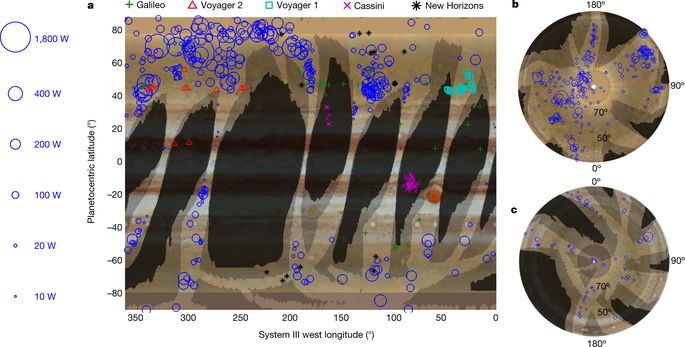Our official English website, www.x-mol.net, welcomes your feedback! (Note: you will need to create a separate account there.)
Prevalent lightning sferics at 600 megahertz near Jupiter’s poles
Nature ( IF 64.8 ) Pub Date : 2018-06-01 , DOI: 10.1038/s41586-018-0156-5 Shannon Brown , Michael Janssen , Virgil Adumitroaie , Sushil Atreya , Scott Bolton , Samuel Gulkis , Andrew Ingersoll , Steven Levin , Cheng Li , Liming Li , Jonathan Lunine , Sidharth Misra , Glenn Orton , Paul Steffes , Fachreddin Tabataba-Vakili , Ivana Kolmašová , Masafumi Imai , Ondřej Santolík , William Kurth , George Hospodarsky , Donald Gurnett , John Connerney
Nature ( IF 64.8 ) Pub Date : 2018-06-01 , DOI: 10.1038/s41586-018-0156-5 Shannon Brown , Michael Janssen , Virgil Adumitroaie , Sushil Atreya , Scott Bolton , Samuel Gulkis , Andrew Ingersoll , Steven Levin , Cheng Li , Liming Li , Jonathan Lunine , Sidharth Misra , Glenn Orton , Paul Steffes , Fachreddin Tabataba-Vakili , Ivana Kolmašová , Masafumi Imai , Ondřej Santolík , William Kurth , George Hospodarsky , Donald Gurnett , John Connerney

|
Lightning has been detected on Jupiter by all visiting spacecraft through night-side optical imaging and whistler (lightning-generated radio waves) signatures1–6. Jovian lightning is thought to be generated in the mixed-phase (liquid–ice) region of convective water clouds through a charge-separation process between condensed liquid water and water-ice particles, similar to that of terrestrial (cloud-to-cloud) lightning7–9. Unlike terrestrial lightning, which emits broadly over the radio spectrum up to gigahertz frequencies10,11, lightning on Jupiter has been detected only at kilohertz frequencies, despite a search for signals in the megahertz range12. Strong ionospheric attenuation or a lightning discharge much slower than that on Earth have been suggested as possible explanations for this discrepancy13,14. Here we report observations of Jovian lightning sferics (broadband electromagnetic impulses) at 600 megahertz from the Microwave Radiometer15 onboard the Juno spacecraft. These detections imply that Jovian lightning discharges are not distinct from terrestrial lightning, as previously thought. In the first eight orbits of Juno, we detected 377 lightning sferics from pole to pole. We found lightning to be prevalent in the polar regions, absent near the equator, and most frequent in the northern hemisphere, at latitudes higher than 40 degrees north. Because the distribution of lightning is a proxy for moist convective activity, which is thought to be an important source of outward energy transport from the interior of the planet16,17, increased convection towards the poles could indicate an outward internal heat flux that is preferentially weighted towards the poles9,16,18. The distribution of moist convection is important for understanding the composition, general circulation and energy transport on Jupiter.Observations of broadband emission from lightning on Jupiter at 600 megahertz show a lightning discharge mechanism similar to that of terrestrial lightning and indicate increased moist convection near Jupiter’s poles.
中文翻译:

木星两极附近 600 兆赫兹的普遍闪电
所有来访的航天器都通过夜间光学成像和哨声(闪电产生的无线电波)特征 1-6 在木星上探测到闪电。木星闪电被认为是通过冷凝液态水和水冰粒子之间的电荷分离过程在对流水云的混合相(液态冰)区域产生的,类似于陆地(云到云)闪电7-9。与在无线电频谱上广泛发射高达千兆赫频率 10,11 的地面闪电不同,木星上的闪电仅在千赫频率下被检测到,尽管搜索了兆赫范围内的信号 12。强烈的电离层衰减或闪电放电比地球上的慢得多,已被建议作为这种差异的可能解释13,14。在这里,我们报告了从朱诺号航天器上的微波辐射计 15 对 600 兆赫兹的木星闪电(宽带电磁脉冲)的观测。这些探测表明,木星闪电放电与之前认为的地球闪电并无区别。在朱诺号的前八个轨道上,我们探测到了 377 次从极到极的闪电。我们发现闪电在极地地区普遍存在,在赤道附近没有,在北半球最常见,在北纬 40 度以上的纬度。因为闪电的分布是潮湿对流活动的代表,它被认为是从行星内部向外传输能量的重要来源 16,17,向两极的对流增加可能表明向外的内部热通量优先向两极加权9,16,18。湿对流的分布对于了解木星的组成、一般环流和能量传输很重要。对木星上 600 兆赫兹闪电宽带发射的观测表明,闪电放电机制类似于地面闪电,并表明木星两极附近的湿对流增加.
更新日期:2018-06-01
中文翻译:

木星两极附近 600 兆赫兹的普遍闪电
所有来访的航天器都通过夜间光学成像和哨声(闪电产生的无线电波)特征 1-6 在木星上探测到闪电。木星闪电被认为是通过冷凝液态水和水冰粒子之间的电荷分离过程在对流水云的混合相(液态冰)区域产生的,类似于陆地(云到云)闪电7-9。与在无线电频谱上广泛发射高达千兆赫频率 10,11 的地面闪电不同,木星上的闪电仅在千赫频率下被检测到,尽管搜索了兆赫范围内的信号 12。强烈的电离层衰减或闪电放电比地球上的慢得多,已被建议作为这种差异的可能解释13,14。在这里,我们报告了从朱诺号航天器上的微波辐射计 15 对 600 兆赫兹的木星闪电(宽带电磁脉冲)的观测。这些探测表明,木星闪电放电与之前认为的地球闪电并无区别。在朱诺号的前八个轨道上,我们探测到了 377 次从极到极的闪电。我们发现闪电在极地地区普遍存在,在赤道附近没有,在北半球最常见,在北纬 40 度以上的纬度。因为闪电的分布是潮湿对流活动的代表,它被认为是从行星内部向外传输能量的重要来源 16,17,向两极的对流增加可能表明向外的内部热通量优先向两极加权9,16,18。湿对流的分布对于了解木星的组成、一般环流和能量传输很重要。对木星上 600 兆赫兹闪电宽带发射的观测表明,闪电放电机制类似于地面闪电,并表明木星两极附近的湿对流增加.


























 京公网安备 11010802027423号
京公网安备 11010802027423号